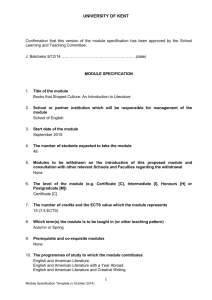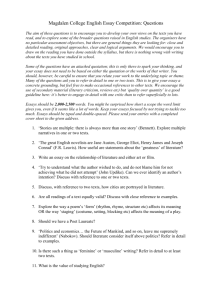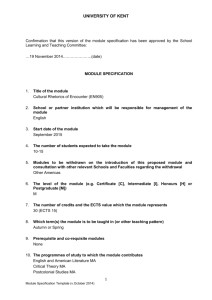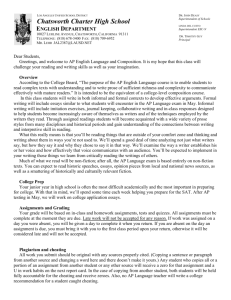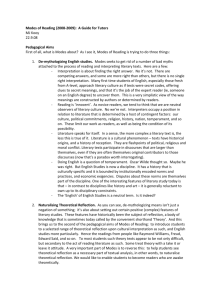University of Kent
advertisement
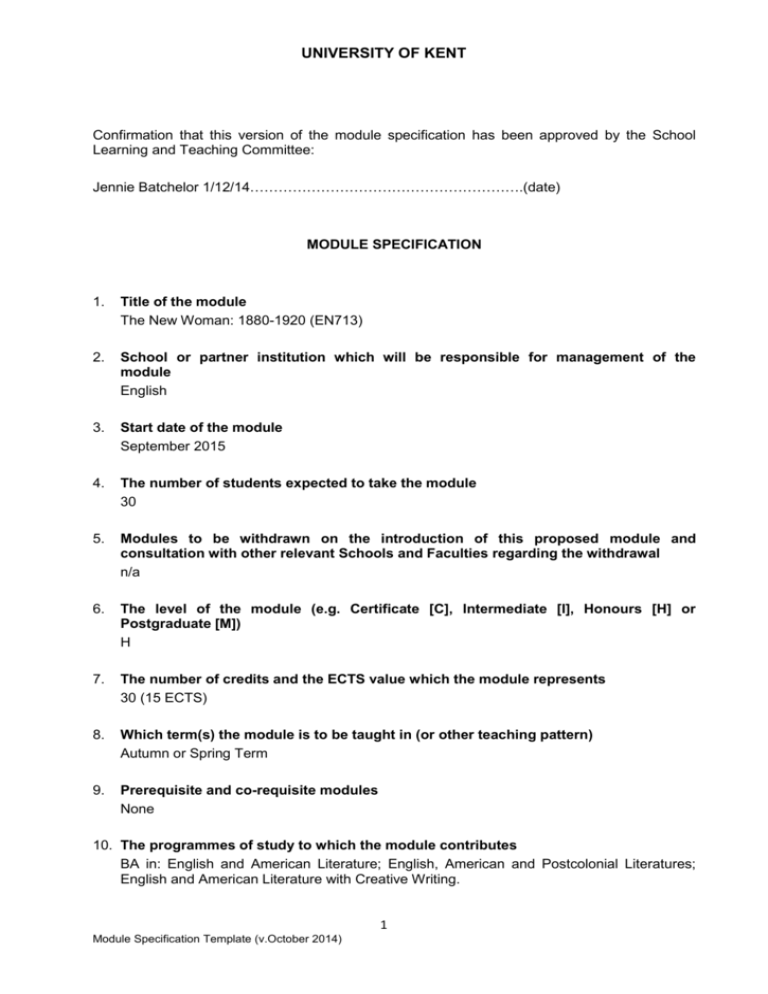
UNIVERSITY OF KENT Confirmation that this version of the module specification has been approved by the School Learning and Teaching Committee: Jennie Batchelor 1/12/14………………………………………………….(date) MODULE SPECIFICATION 1. Title of the module The New Woman: 1880-1920 (EN713) 2. School or partner institution which will be responsible for management of the module English 3. Start date of the module September 2015 4. The number of students expected to take the module 30 5. Modules to be withdrawn on the introduction of this proposed module and consultation with other relevant Schools and Faculties regarding the withdrawal n/a 6. The level of the module (e.g. Certificate [C], Intermediate [I], Honours [H] or Postgraduate [M]) H 7. The number of credits and the ECTS value which the module represents 30 (15 ECTS) 8. Which term(s) the module is to be taught in (or other teaching pattern) Autumn or Spring Term 9. Prerequisite and co-requisite modules None 10. The programmes of study to which the module contributes BA in: English and American Literature; English, American and Postcolonial Literatures; English and American Literature with Creative Writing. 1 Module Specification Template (v.October 2014) UNIVERSITY OF KENT 11. The intended subject specific learning outcomes On successful completion of this module, students will have acquired: 11.1 Detailed knowledge of New Woman literature as an identifiable sub-genre of literature chiefly in novels and short stories but also evident in journalism and drama in the period 1880-1920. 11.2 Knowledge of the social, cultural and political contexts in which the New Woman phenomenon emerged, focusing on Britain in the period 1880-1920, but with an awareness of the global spread of this phenomenon. 11.3 A conceptual understanding of how New Woman literature deployed or adapted conventions of literature drawn from realism, decadence and modernism. 11.4 Enhanced understanding of how the New Woman phenomenon has been rediscovered and examined in current literary criticism and cultural history, from the 1990s to the present. 11.5 Enhanced knowledge of the writing careers and the publication history of the authors studied. 12. The intended generic learning outcomes On successful completion of this module, students will be able to: 12.1 Apply the methods, techniques and terminology of close reading to a range of literary texts in different genres. 12.2 Apply understandings of historical context to the interpretation of literary texts. 12.3 Undertake self-directed research and critically evaluate secondary theoretical or historical perspectives in that research. 12.4 Construct coherent, articulate and well-supported arguments both in oral presentations and written work. 13. A synopsis of the curriculum The New Woman, a controversial figure who became prominent in British literature in the late nineteenth century, challenged traditional views of femininity and represented a more radical understanding of women’s nature and role in society. She was associated with a range of unconventional behaviour – from smoking and bicycle-riding to sexuality outside marriage and political activism. This module will examine some of the key literary texts identified with the New Woman phenomenon including women’s journalism in the period. The module’s reading will be organised around central thematic concerns such as: sexuality and motherhood; suffrage and politics; career and creativity. We will consider to what extent the New Woman was a media construction or whether the term reflected the lives of progressive women in the period. This module will also examine how the New Woman became a global phenomenon, beginning with the plays of Henrik Ibsen, before spreading to literature produced around the world by writers from Britain (Mona Caird, Amy Levy, Evelyn Sharp) America (Charlotte Perkins Gilman), Australia (George Egerton), and New Zealand (Katherine Mansfield). The module will also consider the legacy of the New Woman into the early modernist period, through studying Virginia Woolf’s novel that depicts the suffrage movement, Night and Day. 14. Indicative Reading List Primary Texts: Caird, M. (1989) The Daughters of Danaus. New York: CUNY Press. 2 Module Specification Template (v.October 2014) UNIVERSITY OF KENT Ibsen, H. (2003) A Doll’s House and Other Plays. Harmondsworth: Penguin. Levy, A. (2006) The Romance of a Shop. Peterborough, ON.: Broadview. Showalter, E. (ed.) (1993) Daughters of Decadence: Women Writers of the Fin de Siècle. London: Virago. Votes for Women and The Freewoman (suffragette newspapers available free online) Woolf, V. (2009) Night and Day. Oxford: Oxford University Press. Secondary Texts: Heilman, A. (2000) New Woman Fiction: Women Writing First-Wave Feminism. Basingstoke: Palgrave Macmillan. Parkins, W. (2009) Mobility and Modernity in British Women’s Novels, 1850s-1930s: Women Moving Dangerously. Basingstoke: Palgrave Macmillan. 15. Learning and Teaching Methods, including the nature and number of contact hours and the total study hours which will be expected of students, and how these relate to achievement of the intended module learning outcomes Over the term, this module will be taught as follows: 10 x 2 hour seminars 10 x 1 hour lectures and / or essay-writing and research skills workshops Independent learning hours expected of each student (including reading, research, private study, assessment work) = 270 Total number of study hours = 300. Achievement of module learning outcomes: Lectures, seminar discussions (with suggested further reading and discussion topics provided), personal research, seminar presentations, essays and private study will ensure that the subject specific learning outcomes are met (11.1-5). Seminar exercises on close-reading and a requirement that essays show evidence of close reading will address generic learning outcome 12.1. Essay instructions will require that essays address issues of historical context to the interpretation of literary texts will address generic learning outcome 12.2. Essay instructions that require students to undertake secondary research (and show evidence of this in their essays) will address generic learning outcome 12.3. Essays and the required seminar presentation will address the generic learning outcome 12.4 regarding skills in oral and written presentations. 16. Assessment methods and how these relate to testing achievement of the intended module learning outcomes The module will be assessed on the basis of two evenly-weighted essays (2000 words each), accounting for 80% of the module’s mark. These essays will require students to demonstrate detailed knowledge of New Woman texts and contexts (11.1 11.2, 11.5, 12.2), evidence of close reading from selections of literary texts (12.1), as well as supporting secondary research (11.4, 12.3), and to organize their essays around a coherent argument (12.4). There will be a small research project (1000 words), accounting for 10% of the module’s mark. Students will be required to undertake self-directed research (in line with 12.3) in order to submit an overview of either a key New Woman writer or a 3 Module Specification Template (v.October 2014) UNIVERSITY OF KENT specific issue or campaign identified with the New Woman in the period 1880-1920 (in line with module specific learning outcomes 11.5, 11.1, 11.2). The remaining 10% will derive from a seminar participation mark covering the students’ contribution to seminar discussions across the term (generic learning outcomes 12.4, 12.1 and 12.2). The provision of suggested topics for discussion and further reading will guide the students’ preparation for each seminar, contributing to the acquisition of specialist knowledge regarding the New Woman phenomenon and its historical context (specific learning outcomes 11.1-5). 17. Implications for learning resources, including staff, library, IT and space Standard seminar/lecture rooms with audio-visual equipment. Much of the critical material is held in the library but some additional primary and secondary texts will need to be purchased. 18. The School recognises and has embedded the expectations of current disability equality legislation, and supports students with a declared disability or special educational need in its teaching. Within this module we will make reasonable adjustments wherever necessary, including additional or substitute materials, teaching modes or assessment methods for students who have declared and discussed their learning support needs. Arrangements for students with declared disabilities will be made on an individual basis, in consultation with the University’s disability/dyslexia support service, and specialist support will be provided where needed. 19. Campus(es) or Centre(s) where module will be delivered: Canterbury If the module is part of a programme in a Partner College or Validated Institution, please complete sections 20 and 21. If the module is not part of a programme in a Partner College or Validated Institution these sections can be deleted. 20. Partner College/Validated Institution: None 21. University School responsible for the programme: English 4 Module Specification Template (v.October 2014)




